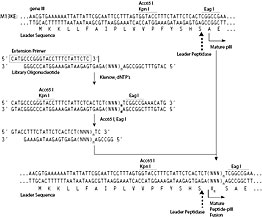Ph.D.™ Peptide Display Cloning System
Product information| Code | Name | Size | Quantity | Price | |
|---|---|---|---|---|---|
E8101S |
Ph.D. Peptide Display Cloning System |
20 µg | - | Unavailable in your region |
Ph.D.™ Peptide Display Cloning System
Product Introduction
The Ph.D.™ Peptide Display Cloning System contains M13KE vector, the parent vector of NEB’s Ph.D. libraries. The included M13 extension primer is used to make DNA duplex out of a user provided synthetic oligo, with or without random bases. The display system is best used to display small peptides, i.e. sequences of 50 amino acids or less.
- M13KE Vector is based on M13mp18 containing the entire M13 genome, with specific cloning sites at the 5’ gIII, encoding pIII coat protein
- Allows for user-designed custom peptide library construction
- May be transfected into F’ E. coli to obtain infectious phage
| Catalog # | Size | Concentration |
|---|---|---|
| E8101S | 20 µg |
- Product Information
- Protocols, Manuals & Usage
- FAQs & Troubleshooting
- Citations & Technical Literature
- Quality, Safety & Legal
- Other Products You May Be Interested In
Product Information
Description
M13KE is a simple M13 derivative in which cloning sites have been introduced at the 5´ end of gene III for display of short peptide sequences as N-terminal pIII fusions. Because this is a phage, rather than a phagemid vector, all 5 copies of pIII on the surface of each virion will be fused to the cloned peptide. Since displayed proteins longer than 20–30 amino acids have a deleterious effect on the infectivity function of pIII, this vector is suitable only for the display of short peptides. Additionally, the vector does not carry a plasmid replicon or antibiotic resistance, so it is necessary to propagate the vector as phage, rather than a plasmid (i.e., titer for plaques, not colonies). This simplifies the intermediate amplification steps during panning considerably, as it is not necessary to express antibiotic genes before plating, or to use helper phage during amplification. The steps necessary to clone a peptide library into M13KE are outlined below. To clone a single peptide sequence, reactions can be scaled down.
- This product is related to the following categories:
- Phage Display
- This product can be used in the following applications:
- Phage Display
Kit Components
System Components
The following reagents are supplied with this product:
| NEB # | Component Name | Component # | Stored at (°C) | Amount | Concentration | |
|---|---|---|---|---|---|---|
Properties & Usage
Related Products
Companion Products
References
- Sambrook, J. and Russell D.W (2001). Molecular Cloning: A Laboratory Manual, (3rd ed.). Cold Spring Harbor, Cold Spring Harbor Laboratory Press.
Protocols, Manuals & Usage
Protocols
Manuals
The Product Manual includes details for how to use the product, as well as details of its formulation and quality controls.
Application Notes
FAQs & Troubleshooting
FAQs
- Can cDNA libraries be cloned into M13KE?
- Can I display antibody fragments or proteins at the N-terminus of pIII coat protein with M13KE?
- What are the differences between pIII and pVIII display?
- Does the Ph.D.™ Phage Display Cloning System come with double-stranded DNA vector?
- What type of strain do I use with the Ph.D.™ Phage Display Cloning System?
- I have done all the standard troubleshooting for my cloning and transfection steps and I still cannot get the desired clone in M13KE?
Troubleshooting
Citations & Technical Literature
Citations
Additional Citations
- Kaur K, Taneja NK, Dhingra S, Tyagi JS (2014) DevR (DosR) mimetic peptides impair transcriptional regulation and survival of Mycobacterium tuberculosis under hypoxia by inhibiting the autokinase activity of DevS sensor kinase BMC Microbiol; 14, 195. PubMedID: 25048654, DOI: 10.1186/1471-2180-14-195
Quality, Safety & Legal
Quality Assurance Statement
Quality Control tests are performed on each new lot of NEB product to meet the specifications designated for it. Specifications and individual lot data from the tests that are performed for this particular product can be found and downloaded on the Product Specification Sheet, Certificate of Analysis, data card or product manual. Further information regarding NEB product quality can be found here.Specifications
The Specification sheet is a document that includes the storage temperature, shelf life and the specifications designated for the product. The following file naming structure is used to name these document files: [Product Number]_[Size]_[Version]Certificate Of Analysis
The Certificate of Analysis (COA) is a signed document that includes the storage temperature, expiration date and quality controls for an individual lot. The following file naming structure is used to name these document files: [Product Number]_[Size]_[Version]_[Lot Number]Safety DataSheets
The following is a list of Safety Data Sheet (SDS) that apply to this product to help you use it safely.Ph.D.™ Peptide Display Cloning System
M13 Extension Primer
Legal and Disclaimers
Products and content are covered by one or more patents, trademarks and/or copyrights owned or controlled by New England Biolabs, Inc (NEB). The use of trademark symbols does not necessarily indicate that the name is trademarked in the country where it is being read; it indicates where the content was originally developed. The use of this product may require the buyer to obtain additional third-party intellectual property rights for certain applications. For more information, please email busdev@neb.com.This product is intended for research purposes only. This product is not intended to be used for therapeutic or diagnostic purposes in humans or animals.
New England Biolabs (NEB) is committed to practicing ethical science – we believe it is our job as researchers to ask the important questions that when answered will help preserve our quality of life and the world that we live in. However, this research should always be done in safe and ethical manner. Learn more.
Other Products You May Be Interested In
The supporting documents available for this product can be downloaded below.
Protocol
M13 Titer Protocol
Protocol
M13 Amplification
Protocol
Transfection of M13 DNA Protocol
Protocol
Transfection of M13 DNA Protocol
Protocol
Transfection of M13 DNA Protocol
Protocol
Transfection of M13 DNA Protocol
